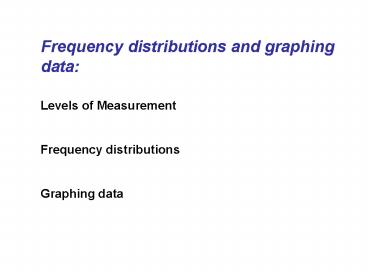Frequency distributions and graphing data: - PowerPoint PPT Presentation
1 / 19
Title:
Frequency distributions and graphing data:
Description:
Frequency distributions and graphing data: Levels of Measurement Frequency distributions Graphing data Stages in scientific investigation: Obtain your data: Usually ... – PowerPoint PPT presentation
Number of Views:129
Avg rating:3.0/5.0
Title: Frequency distributions and graphing data:
1
Frequency distributions and graphing
data Levels of Measurement Frequency
distributions Graphing data
2
Stages in scientific investigation Obtain your
data Usually get data from a sample, taken from
a population. Descriptive statistics Reveal the
information that's lurking in your
data. Inferential statistics Use data from a
sample to reveal characteristics of the
population from which the sample data were
presumably selected.
3
Levels of measurement 1. Nominal (categorical
or frequency data) When numbers are used as
names. e.g. street numbers, footballers' numbers.
All you can do with nominal data is count how
often each number occurs (i.e. get frequencies of
categories).
4
2. Ordinal When numbers are used as ranks. e.g.
order of finishing in a race the first three
finishers are "1", "2" and "3", but the
difference between "1" and "2" is unlikely to be
the same as between "2" and "3".
Many measurements in psychology are ordinal data
- e.g., attitude scales.
5
3. Interval When measurements are made on a
scale with equal intervals between points on the
scale, but the scale has no true zero point. e.g.
temperature on Celsius scale 100 is water's
boiling point 0 is an arbitrary zero-point (when
water freezes), not a true absence of
temperature. Equal intervals represent equal
amounts, but ratio statements are meaningless -
e.g., 60 deg C is not twice as hot as 30 deg!
Many measurements in psychology are interval data
- e.g., IQ scores.
6
4. Ratio When measurements are made on a scale
with equal intervals between points on the scale,
and the scale has a true zero point. e.g. height,
weight, time, distance.
Measurements in psychology which are ratio data
include reaction times, number correct, error
scores.
7
Frequency distributions 50 scores on a
statistics exam (max 100) 84 82 72 70 72
80 62 96 86 68 68 87 89 85 82 87 85 84 88 89 86
86 78 70 81 70 86 88 79 69 79 61 68 75 77 90 8
6 78 89 81 67 91 82 73 77 80 78 76 86 83
8
Raw (ungrouped) Frequency Distribution Score
Freq Score Freq Score Freq Score
Freq 96 1 86 6 76 1 66 0 95 0 85 2 75 1 65 0 9
4 0 84 2 74 0 64 0 93 0 83 1 73 1 63 0 92 0 82 3
72 2 62 1 91 1 81 2 71 0 61 1 90 1 80 2 70 3
89 3 79 2 69 1 88 2 78 3 68 3 87 2 77 2 67
1
9
Grouped Frequency Distributions
Class interval width 3 Class interval width 3
Score Frequency
94-96 1
91-93 1
88-90 6
85-87 10
82-84 6
79-81 6
76-78 6
73-75 2
70-72 5
67-69 5
64-66 0
61-63 2
Class interval width 5 Class interval width 5
Score Frequency
95-99 1
90-94 2
85-89 15
80-84 10
75-79 9
70-74 6
65-69 5
60-64 2
10
Grouped Frequency Distributions
11
Cumulative Frequency Distributions
Score Raw Freq.
(total in each cell)
94-96 1
91-93 1
88-90 6
85-87 10
82-84 6
79-81 6
76-78 6
73-75 2
70-72 5
67-69 5
64-66 0
61-63 2
Cumulative freq.
(each cell total all preceding cell totals)
50
49
48
42
32
26
20
14 ( 25502)
12 ( 5502)
7 ( 502)
2 ( 02)
2 ( 2)
Cumulative freq.
( cum. freq. as of total)
100
98
96
84
64
52
40
28 ( (14/50)100 )
24 ( (12/50)100 )
14 ( (7/50)100 )
4 ( (2/50)100 )
4 ( (2/50)100 )
12
(No Transcript)
13
Relative Frequency Distributions Useful for
comparing groups with different totals.
Group A N 50 Group A N 50
Score Raw Freq.
96-100 3
91-95 4
86-90 11
81-85 15
76-80 8
71-75 4
66-70 2
61-65 3
Total 50
Group B N 80 Group B N 80
Score Raw Freq.
96-100 3
91-95 4
86-90 18
81-85 24
76-80 11
71-75 9
66-70 5
61-65 6
Total 80
Rel. Freq.
6
8
22
30
16
8
4
6
100
Rel. Freq.
3.75
5.00
22.50
30.00
13.75
11.25
6.25
7.50
100
Relative frequency (cell total/overall total) x
100
14
Raw Frequency and Relative Frequency
Distributions Only the scale of the graph
changes - not the pattern of frequencies.
15
(No Transcript)
16
Effects of aspect ratio and scale on graph
appearance (a) A graph aimed at giving an
accurate impression...
17
(b) A tall thin graph exaggerates apparent
differences...
18
(c) A low wide graph minimises apparent
differences...
19
(d) Starting the scale at a value other than zero
can also exaggerate apparent differences.































